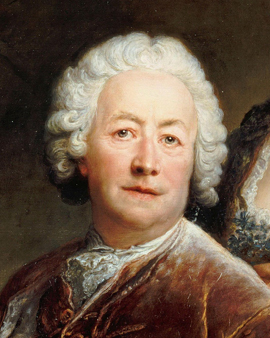


Antoine Pesne was a French painter who achieved Europe-wide fame primarily for his portraits of the Prussian aristocracy of the 18th century. Pesne is considered one of the founders of Rococo painting, particularly Friderician Rococo, and in addition to his portraits he created a series of ambitious, large-scale ceiling paintings as well as a series on dancers and actresses who performed at the Berlin Opera, based on the style of Antoine Watteau.
Born in Paris on 29 May 1683, Pesne first studied in his native city with his uncle, the painter Charles de la Fosse, and other leading French portraitists, such as Nicolas de Largillière and HHyacinthe Francois Rigaud, before enrolling at the Académie Royale in Rome on a scholarship. This scholarship enabled him to spend extended periods in Venice, Naples, and Rome, where he was taught for several months by the noted Baroque painter Andrea Cellesti. In 1707, Pesne's full-length portrait of the Prussian envoy in Venice, Baron von Knyphausen, attracted the attention of Frederick I of Prussia, who appointed him court portraitist to succeed the Dutchman Augustin Terwesten. This prestigious position was to have a lasting impact on his influence and importance to European court painting. Through his position at the Prussian court he met the architect Georg Wenzeslaus von Knobelsdorff in the 1730s, with whom he undertook the artistic design of Rheinsberg, Charlottenburg, Sanssouci and Potsdam City Palace. His lifelong patron King Frederick financed his house at Oberwallstrasse 3 in Berlin, where he lived until his death on August 5, 1757. Pesne was not only highly esteemed by his contemporaries. His reputation and his services to the Prussian state prompted the magistrate of Berlin, even 150 years after his death, to place a memorial plaque on the late painter's house in 1902, which is no longer preserved today. Historians assume that it was melted down during the Second World War for the purpose of weapons production. Currently, Pesne's works can be found in the collections of institutions such as the Charlottenburg, Rheinsberg and Sanssouci palaces, as well as in many German museums.
Pesne's distinctive stylistic qualities include a soft discreet application of paint that seems to anticipate the Impressionist works of Pierre-August Renoir, and his ability to place the portrayed aristocrats in a larger context of meaning through allegorical and mythological allusions.

Antoine Pesne was a French painter who achieved Europe-wide fame primarily for his portraits of the Prussian aristocracy of the 18th century. Pesne is considered one of the founders of Rococo painting, particularly Friderician Rococo, and in addition to his portraits he created a series of ambitious, large-scale ceiling paintings as well as a series on dancers and actresses who performed at the Berlin Opera, based on the style of Antoine Watteau.
Born in Paris on 29 May 1683, Pesne first studied in his native city with his uncle, the painter Charles de la Fosse, and other leading French portraitists, such as Nicolas de Largillière and HHyacinthe Francois Rigaud, before enrolling at the Académie Royale in Rome on a scholarship. This scholarship enabled him to spend extended periods in Venice, Naples, and Rome, where he was taught for several months by the noted Baroque painter Andrea Cellesti. In 1707, Pesne's full-length portrait of the Prussian envoy in Venice, Baron von Knyphausen, attracted the attention of Frederick I of Prussia, who appointed him court portraitist to succeed the Dutchman Augustin Terwesten. This prestigious position was to have a lasting impact on his influence and importance to European court painting. Through his position at the Prussian court he met the architect Georg Wenzeslaus von Knobelsdorff in the 1730s, with whom he undertook the artistic design of Rheinsberg, Charlottenburg, Sanssouci and Potsdam City Palace. His lifelong patron King Frederick financed his house at Oberwallstrasse 3 in Berlin, where he lived until his death on August 5, 1757. Pesne was not only highly esteemed by his contemporaries. His reputation and his services to the Prussian state prompted the magistrate of Berlin, even 150 years after his death, to place a memorial plaque on the late painter's house in 1902, which is no longer preserved today. Historians assume that it was melted down during the Second World War for the purpose of weapons production. Currently, Pesne's works can be found in the collections of institutions such as the Charlottenburg, Rheinsberg and Sanssouci palaces, as well as in many German museums.
Pesne's distinctive stylistic qualities include a soft discreet application of paint that seems to anticipate the Impressionist works of Pierre-August Renoir, and his ability to place the portrayed aristocrats in a larger context of meaning through allegorical and mythological allusions.
Page 1 / 1






